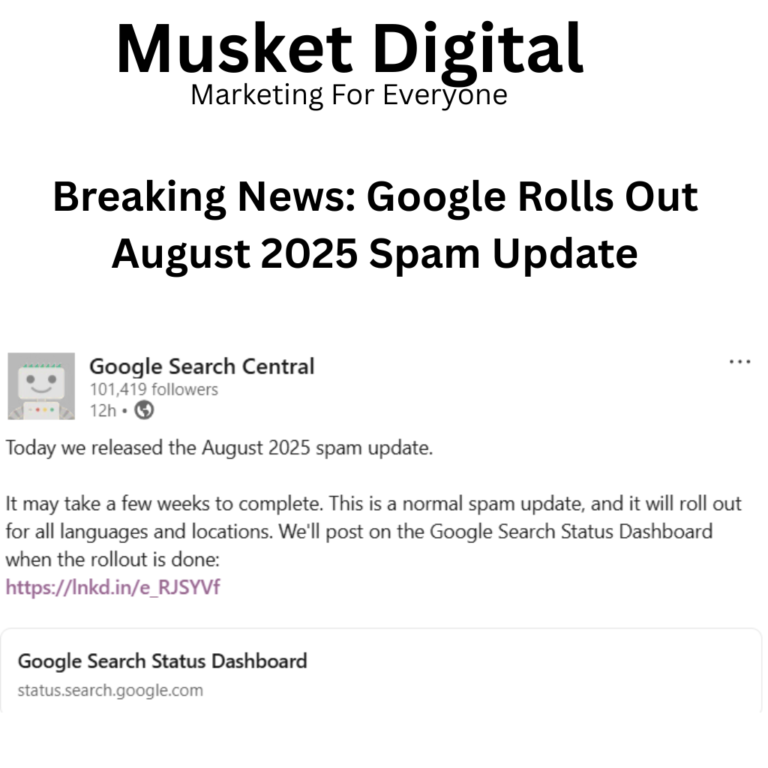Google News: Rolls Out August 2025 Spam Update
Blog
Breaking News: Google Rolls Out August 2025 Spam Update
Today we released the August 2025 spam update.
It may take a few weeks to complete. This is a normal spam update, and it will roll out for all languages and locations. We’ll post on the Google Search Status Dashboard when the rollout is done: https://www.linkedin.com/posts/googlesearchcentral_google-search-status-dashboard-activity-7366138602071760897-5s1Q?utm_source=share&utm_medium=member_desktop&rcm=ACoAAEUvCsYBtSbP3tPsYmeDao9EdLFoSsPw4ho
Google News: Rolls Out August 2025 Spam Update – What You Need to Know
Google has made the formal announcement regarding its August 2025 Spam Update, and as usual, the SEO community has questions. What are the implications of this upgrade for website owners and SEO professionals, and for those who depend on natural search? Is there cause for concern if your rankings drop? And, of course, most importantly, how do you protect your site?
In this article, we will outline the details of the upgrade, present Google’s official notes, and offer actionable advice so your website will remain compliant and unaffected.
A Brief Overview of the Update
According to Google, the August 2025 Spam Update began rolling out this week of August 26. The rollout is global and applies to all languages and regions. Google has said the update will take several weeks to finish. As with any such update, there are chances of fluctuations in search rankings afterwards. Some sites might see their rankings drop for a while, and others might gain if they have been doing ethical SEO. Once the rollout has been implemented, Google will announce it on the Google Search Status Dashboard, their formal vehicle for notifying updates.
Why Does Google Release Spam Updates?
Google has a simple goal: provide users with reliable, high-quality content, and safe search results. Spam updates are designed to target websites that attempt to manipulate rankings by violating Google’s policies. These updates cleanse the ecosystem from unwanted or low-quality spam content from searches. For genuine businesses and sites playing according to the rules, these updates are mostly beneficial as they help reduce competition from spam sites.
In contrast, those that participate in black-hat SEO or malicious activities will experience loss of ranks or removal from search rankings.
Key Issues Google Is Addressing in This Spam Update
Google has signaled several key practices it is targeting with this algorithm upgrade. To protect your website, closely look at these areas before fluctuating your website ranking and visibility on Google SERP : Lets Go !!
1-Cloaking
Cloaking involves showing the search engine one version of the page and showing the user another version.
For example, showing keyword-optimized content to Google and showing a clean, irrelevant page to users. Google spiders are very advanced now and will spot cloaking tactics quickly.
Tip: Always ensure that the content you provide to users is the same as what search engines see.
2-Doorway Abuse
Doorway pages are made for the sole purpose of ranking for certain keywords and forwarding the user somewhere else. These are of no use. The new algorithm enhances detection of this kind of practice.
Tip: Focus on building unique, valuable landing pages instead of doorway-style content.
3-Expired Domain Abuse
Some SEOs buy expired domains with existing authority and use them to rank unrelated or low-quality content. Google has become stricter against this, especially when it’s done at scale.
Tip: When using expired domains, make sure they have legitimate uses and not for mere SEO purposes.
4-Hacked Content
Websites with hacked pages can unknowingly host spam or malicious content. This not only affects rankings but also damages reputation.
Tip: Always check your site for security holes and use good security practices.
5-Hidden Text and Link Abuse
Keyword hiding, invisible text, or links disguised as CSS or HTML are an old trick and still linger on. The new Google algorithm update has intentions of penalizing this kind of manipulation.
Tip: Make all of your on-page features readily seen and usable.
6-Keyword Stuffing
Over-optimization of repetition of keywords unnaturally is one of the common spam methods. Google is solidifying punishment for doing so.
Tip: Write for humans first. Write with natural use of keywords, and prioritize contextual relevance.
7-Link Spam
Buying, selling, or exchanging links solely to manipulate rankings is a major red flag. This includes spammy guest posts, PBNs, and link farms.
Tip: Build links organically with PR, partnerships, and content of value.
8-Machine-Generated Traffic
Automated bots or software which transmit fake traffic signals for manipulating rankings lie under the monitoring of Google.
Tip: Genuine engagement and quality traffic matter more than artificial signals.
9-Malware and Malicious Activities
Websites distributing malware or having malicious downloads will face severe penalties, as user safety stands as the topmost priority for Google.
Tip: Protect your hosting, use SSL, and do not use dodgy scripts or plugins.
10-Misleading Functionality
It will focus on pages that trick users with made-up buttons, ads disguised as content, or misrepresentative functionality.
Tip: Be clear and focus on user trust.
11-Scaled Content Abuse
Publishing massive amounts of low-quality, auto-generated content just for ranking is being cracked down upon.
Tip: Scale with quality, not quantity. All pieces should include genuine user intent.
12-Scraping
Copying content from other sites without providing value has also been another spam technique focused on here.
Tip: Genuine, original, and informative content always wins.
13-Site Reputation Abuse
Some high-authority sites sell subdomains or pages for unrelated spammy content (like payday loans or casino links). Google is addressing this loophole.
Tip: Maintain your brand image intact with content focused on your niche.
14-Sneaky Redirects
Directing users without their permission to irrelevant or malicious sites is plain violation.
Tip: Use redirects judiciously and only if they enhance user experience.
15-User-Generated Spam
Blogs, forums, or communities tend to suffer from spam consisting of irrelevant posts, links, or advertising. The new version focuses on tidying up such areas.
Tip: Regularly moderate user submissions and comments.
What This Means for You
As long as your site follows ethical SEO practices and has legitimate value, your website will be good. You will actually see advantages as your competitors who are dependent on spam lose rankings. If, on the other hand, you have tried shortcuts or dubious methods, now is the time to review your site and correct problems prior to Google doing so itself with its algorithm.
Action Plan for Webmasters and SEOs
The following are practical means of being safe while on rollout:
-
- Check your site for any of the foregoing spam indicators.
-
- Review Search Console for security problems or manual actions.
-
- Refresh existing content so that it’s relevant, new, and valuable.
-
- Pay attention to E-E-A-T (Experience, Expertise, Authoritativeness, Trustworthiness).
-
- Secure with HTTPS, firewalls, and frequent scanning.
-
- Create quality backlinks organically rather than opting for paid networks.
-
- Monitor rankings but don’t panic if you see short-term fluctuations.
Key Takeaway
Google August 2025 Spam Update isn’t new — it’s one of Google’s lines of projects for keeping search results clean, safe, and useful. For legitimate sites, this update will not be a threat and will instead be an opportunity. As Google fine-tunes its algorithms, the distinction between sustainable SEO and tactics of manipulation comes sharply into focus. The point is obvious: think users, not exploits. You build credible content and do your SEO ethically, and not only will you survive this update, but your content will thrive!
